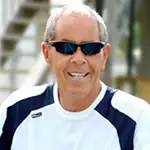Over the years I have developed some of the biggest forehands in the game. Jimmy Arias, Jim Courier, Andre Agassi, Tommy Haas and Xavier Malisse are all fine examples of how to use the forehand as a weapon and control play.
While Malisse, Haas and Agassi have some big backhands to go along with the forehand, Arias and Courier made their careers on the ability to control play from the forehand and minimize the amount of backhands they hit.
Here's one of the ways we work on it at the IMG Bollettieri Academy.
How the drill works: Player A starts in the middle of the court behind the baseline. On the opposite side of the net, player B stands in the deuce corner.
Player B feeds a ball in play to player A. Player A must hit every ball into the deuce corner directly to Player B. Player B can hit the ball anywhere he or she likes to Player A.
Here's the catch: Wherever the ball lands player A must hit a forehand. So if Player B hits the ball into the backhand side of Player A, he or she must run around the backhand and hit a forehand back to Player B.
This drill should be timed, and depending on your conditioning, you can go from 1 to 5 minutes. Be sure to switch Player B into the ad court for the second round to practice hitting that corner also.
Variations: This drill can also be done in a two on one format. Two people will be on one side moving a single player around on the opposite side. The single player must still hit all forehands but now can vary the target to both corners. You may also add targets for the person working on their forehand to hit.
Areas of Focus: Obviously when doing this drill you are working on depth and control with your forehand. But this drill is also a fantastic workout and will help with conditioning tremendously.
Footwork and speed come into play and will improve the more you train in this manner. And finally, you must learn to recognize the ball and even anticipate in order to be successful.
Even without increasing your foot speed, if you can learn to recognize balls earlier and anticipate, your first step will be quicker and you will move faster around the court regardless of whether you are hitting a forehand or a backhand.



